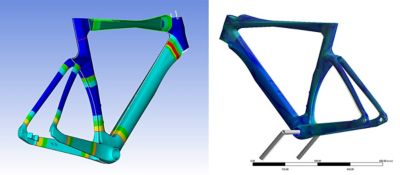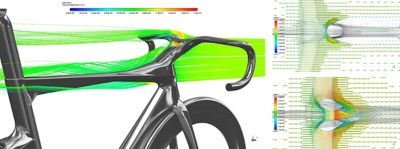ANSYS BLOG
December 21, 2022
Bianchi Takes the Lead with Simulation
If you've ever watched the Tour de France, you may have wondered just how fast those riders actually go. (As fast as they can, of course.) Naturally, having the right bike is a good start. But what does the right tour bike look like? You might want to ask Bianchi. The Italian bike manufacturer’s team is a force in both the race and the sport. Their riders (and bikes) are some of the best in the world, having enjoyed numerous victories finishing in the top spots.
One of the oldest and biggest names in cycling, Bianchi recently began using Ansys software in 2020 on its continued quest to build world-class tour bikes, as well as mountain bikes and e-bikes. In this context, “passing the test” for Bianchi means finding the right stiffness, aerodynamics, and performance in a safe, ISO-compliant frame design enabled by Ansys simulation.
“Our mission is to deliver the best bike in the world,” says Daniel Teran, Product Manager and Design Engineer at Bianchi. “Our analysis depends on what the customer needs. So, if the customer needs performance, then it’s performance. If the customer needs a tour bike, then it should be the best tour bike in the world in terms of comfort or geometry or whatever is needed for that type of bike, which is only achieved by simulation.”
A 70% Reduction in Physical Prototypes Helps Drop the Competition
Bianchi’s core business is producing bicycles for high-performance targets. In this case, the user is a road biker who looks for high-performance bikes with a focus on frame stiffness, weight, and aerodynamics.
“The pressures for touring bike design are tied to the competitive nature of road racing,” says Teran. “The focus is always on designing a lighter, stiffer, faster bike. Those are the three big words in cycling and the biggest engineering challenges we face.”
To this end, Ansys Mechanical structural finite element analysis (FEA) software enables Bianchi to simulate viable design solutions in two to three tries, ultimately reducing the number of prototypes needed for safety testing by 70%. This methodology applies to every frame variation they plan to put on the market. A physical sample of every bike is tested, and if a particular sample does not pass, a second, third, or fourth sample is made until all of the necessary modifications have been completed.

Bianchi uses Ansys Mechanical to develop and optimize its bike frames as pictured above, from composites materials modeling (left) to structural performance testing for stiffness (right).
“We need three prototypes for every size bike we make,” says Teran. “In the past we made basically four modifications to get an acceptable result. With simulation, we know what we have to modify if the frame is not passing, then immediately move on to solve issues. So, most of our frames pass the first time, or in the worst-case scenario, the second. When you’re talking about three separate fatigue tests and two separate impact tests involving two frames, plus one as back-up, the savings can add up to anywhere from thousands to tens of thousands of dollars.”
Overall, Bianchi saves approximately 18 months across the entire development chain using simulation software, from initial design to testing and optimization. Going to market earlier means more sales and a greater competitive advantage in an environment characterized by constant change.
Simulation Puts Riders In the Best Position
Performance optimization of Bianchi’s racing bikes begins well before race day with Ansys Fluent. First, Bianchi engineers study the frameset (frame, seat-post, handlebar, and fork) with dummy components such as wheels and cranks to understand the general behavior of the sections. In parallel, a 3D scan of the rider’s body is used to obtain a polygonal model, which is imported into Ansys SpaceClaim to generate a clean 3D model for further analysis using Fluent.
In this way, Bianchi can study the behavior of the new bike, including the presence of the rider. From this series of simulations, the team can further optimize the frame design to find that sweet spot where the frame works in harmony with the rider’s volume for reducing drag force across different yaw angles (the angle between a cyclist’s direction of motion and the relative wind vector, which is a combination of rider speed and ambient wind direction).

Bianchi uses Ansys Fluent computational fluid dynamics software to do path lines analysis of traditional handlebars (top, right) versus its OltreZero handlebars (bottom, right).
All of this information leads to extremely accurate power and performance predictions by riders for a specific time trial or stage. This level of optimization is something that Bianchi does with their own racing team. Using analysis, models are created that achieve certain characteristics in an effort to help match a rider with the proper bike or find a better one.
“It’s really good to have everything integrated that you are actually using — to have the model in one place using different types of simulations,” says Teran. “I think that is the key point of analysis. And then all the optimization tools that you have in Ansys Workbench, including the ability to update all design points, and then you let it run.”
Gearing Up for Safety with Ansys LS-DYNA
Competitive cycling can be dangerous. During the Tour de France, for example, riders can reach speeds of up to 65 mph (approximately 110 kph) on the downhill,1 making sudden stops potentially perilous. And, as more consumers look to biking as an eco-friendly way to get around, the increase in bike traffic, along with interactions with motor vehicles, pedestrians, and anything else on the path from point A to point B, increase the potential for more accidents.
Working toward higher safety standards for all of their bikes is a priority for Bianchi. To do this, the development team looks to ISO standards as a baseline and then go a bit beyond the typical usage of the bike during safety testing in Ansys LS-DYNA crash test simulation software. Much of the focus is on overall design integrity, as even professional touring bikes are susceptible to damage in certain environments. Then there are components where zero failure is critical, like the fork, or the part of the bike that holds the front wheel.
Fatigue testing using simulation to determine the integrity of the saddle design.
For example, the development team uses LS-DYNA to understand how much energy is absorbed by the front and rear wheels versus the A-frame during a front-end or rear-end collision. Separate analysis in LS-DYNA helped the team understand the level of stress on these individual components versus the combination of the two working together relative to the same amount of energy. In this way, the team can carefully tweak the heights of the drop test done in Bianchi’s Labs to improve safety during impact.
Riding High on New Discoveries
Perhaps the best benefit of using Ansys simulation software was the unexpected discoveries that led Bianchi’s development team to a better assessment of frame stiffness. There is a myth in the cycling industry that of all the elements of the frame, the down tube, or the long tube that runs from head tube down to the pedals needs to be really large to withstand torsional loads. Discoveries made within a simulation environment, however, led Teran to a different conclusion.
“Stiffness really depends on the geometrical harmony between all the tubes of the frame,” says Teran. “Previously, we overlooked the top tube when considering the stiffness of the frame, when actually it is also very important. It’s not just the down tube, which was a great discovery turned competitive advantage for us. We also made new discoveries related to the parts of the frame that influence aerodynamic performance. This has led to further optimization of the seat tube and seat post giving us a really good design performance, which, if not optimized for aero, also contributes to a big portion of the frame drag force.”
Ansys will be featuring our work with Bianchi at CES in January. If you’re there, be sure to visit Ansys booth #4401 to see the E-Omnia, the latest iteration of Bianchi’s e-bikes.